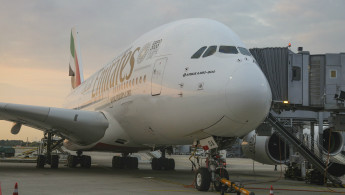Middle East's significant double-digit growth in airline passenger traffic
Middle Eastern carriers registered a double-digit growth in international passenger traffic at the start of summer, outperforming all other regions in June, the International Air Transport Association (IATA) confirmed.
While traditionally it would have been expected of the Middle East to be one of the best performing region in terms of passenger growth, given the sheer dominance of the three main Gulf Carriers: Emirates, Etihad Airways, and Qatar Airways (referred to as the ME3) – the dynamics of the global aviation industry are shifting.
Today, the steadiness of aviation performance for a region as strong, yet as vulnerable as the Middle East widely depends on the current state of its politics, diplomatic relations with the rest of the world, and other external factors, such as the global oil price level.
The increase in passenger traffic in June comes amid a complicated time for the Middle Eastern aviation scene, demonstrating the resilience of the region, and the continued dominance Middle Eastern carriers have on a global scale.
While there are several very well-established airlines in the region – ranging from flag carriers, such as Oman Air & Royal Jordanian, to low-cost airlines, such as Saudi's 'flyadeal' – the reality is that aviation financial performance for the Middle East is almost solely driven by the 'ME3' Gulf carriers.
 |
Middle Eastern aviation continues to prove to be as resilient as ever, and June's figures further reflect that no matter what is thrown at the Gulf carriers these states will continue to outperform the rest of the world when it comes to passenger traffic |  |
These 'super connecter' airlines offer competitive pricing, and have turned the Middle East into the world's one-stop connection point for any destination in the world. Helsinki to Sydney, Tokyo to Sao Paolo, it's all possible via the Gulf.
Read also: How Saudi Arabia is using airspace as a geopolitical weapon
However, with a global economic slowdown, a recent Gulf Crisis (Saudi-led blockade of Qatar), an oil price collapse, and a pilot shortage in the UAE (due to mass pilot resignations) – the last couple of years have been much more turbulent than the region could have ever anticipated.
It's why the Middle East's recent recording of double digit growth in airline passenger traffic is significant. It comes at a time where the region's aviation industry is in a more fragile state than it has experienced for several years.
In Dubai, Emirates has had no choice but to park superjumbo jets in the desert, amid mass pilot resignations over poor working conditions. Further along the coast, Abu Dhabi's Etihad Airways has just received a Fitch Ratings report stating the national airline of the UAE will continue to lose money until at least 2022.
The Credit agency also forecast the Abu Dhabi's Etihad Airways airline to remain the smallest of the Gulf carriers, and found a "high execution risk" in Etihad's turnaround plan.
For Qatar Airways, the airline was forced to erase their two formerly largest markets: Saudi Araba and United Arab Emirates, last year – due to an ongoing Saudi-led blockade on the rich Gulf country.
Read also: Here for the long haul: How Qatar is overcoming the aviation blockade
However, Middle Eastern aviation continues to prove to be as resilient as ever, and June's figures further reflect that no matter what is thrown at the Gulf carriers (or in some cases, what they throw to each other) these oil-rich (UAE) and gas-rich (Qatar) states will continue to outperform the rest of the world when it comes to passenger traffic.
Ultimately, regardless of 'Muslim travel bans', or more antics from an unpredictable Trump White House – there's no changing the fact that more than three billion people live within an eight-hour flight from GCC capitals, including in the fast growing Chinese and Far East markets.
It's why the Gulf carriers continue to shift their focus to Asia, in a bid to tap into the mass-market demand – which will help ease intra-Gulf pressures, and keep the 'connections' flowing for these 'super-connector' carriers.
Had any another region suffered so immensely with various crisis', one would expect to see the numbers continue to fall. Brexit, for example (the planned departure of UK from the European Union) has been enough to significantly weaken the UK's air travel industry. And yet, the UK's 'Exit' from the EU hasn't even started yet.
For Emirates, Etihad, and Qatar Airways, the ongoing support from their largest shareholders – their governments – further ensures the resilient nature of Middle Eastern aviation continues.
Alex Macheras is an aviation analyst, broadcasting on international networks including BBC News, Sky News and Al Jazeera. Macheras has covered the aviation side of the Gulf Crisis since June 2017.
Follow him on Twitter: @AlexInAir


![President Pezeshkian has denounced Israel's attacks on Lebanon [Getty]](/sites/default/files/styles/image_684x385/public/2173482924.jpeg?h=a5f2f23a&itok=q3evVtko)



 Follow the Middle East's top stories in English at The New Arab on Google News
Follow the Middle East's top stories in English at The New Arab on Google News


